
REEL TOP 40 RADIO REPOSITORY

When I was 14, I made my first visit to a radio station, WHB, and was shown around by local legendary DJ, Johnny Dolan. A few months later, the new upstart in town, KUDL, launched its "fake Drake" format, and I quickly made it a point to become acquainted with the jocks there. As soon as I got my driver's license at the age of 16, I took a job as janitor at KUDL. Though placing deodorant tablets in the urinals wasn't exactly in keeping with my life's ambition, having access to the production studio was. That's where I started playing around and making tapes.
When the resident hippie on the sister "underground" station, KCJC-FM, refused to work on Saturday nights, I volunteered for the job - for free. A few months later, I was given my first big shot on KUDL as Bob Scott.
I played the hits at night, and slept through high school in the day. Shortly after high school, I left home with my Saint Bernard Freedom (named by my KUDL listeners) and headed to Tulsa to work at KAKC.
By 1997, I had become an avid golfer and finally left Texas to live every golfer's dream. I became the lead play-by-play voice of PGA TOUR Radio, walking the fairways with Tiger Woods, et al. Then in 1999, I joined Cumulus Broadcasting to run their Central Production Facility.
Today, I'm back in Atlanta running my own shop, Brown Media, Inc..
Having grown up in Kansas City, my first exposure to Top 40 radio was Radio Seventy-ONEderful WHB (World's Happiest Broadcasters), the showcase station in the Todd Storz empire. KAKC, along with KYNO/Fresno and KGB/San Diego, was one of the non-RKO General stations consulted by Bill Drake. And KNUS was the last of Gordon McLendon's stations.
So I consider myself very fortunate to have been influenced early on in my career by these three legendary pioneers in broadcasting. I like to think the influences
If only I'd been more influenced by Kreskin, maybe I'd have had the vision to hang on to all my old aircheck tapes. But, alas, many have found their way into landfills scattered across the fruited plain. That is regrettable, as there were quite a few that might be of general interest today. But who knew that something like the internet would come along? And who knew Uncle Ricky would provide this service? Oh well.
I have dug up a few items from my "Box O' Tapes" that has traveled around the country with me. Enjoy.
The Repository thanks Randy Brown for sharing!
. . . Yours Truly WHB, World's Happiest Broadcasters . . .
[Description by Randy Brown]
Like most radio guys who worked for Bill Drake, I have the fondest memories of radio from that time. The famous Johnny Mann Drake logo melody is still very much alive today. But I recall another melody that I'd long considered one of the best, and yet it seems all but forgotten. A few years ago, I set out on a journey to locate the old PAMS jingles from WHB, Kansas City, the station I grew up listening to. I found them through a jingle collector. (And I owe him a big favor. If you know where he can get the WQAM jingles, let me know.)
This montage of WHB jingles includes cuts from PAMS Series 15 thru 33, as well as the "finger-snap" series produced for WHB in 1969. The famous "Yours Truly WHB" melody was predominantly used from around 1960 until 1969, when the "finger snaps" went on the air. But during a brief spell, WHB turned away from its famous "Yours Truly" melody to use the "Wonderful WHB" logo.
There are representative samples from all three logo melodies on this montage. The most fascinating of all the jingles to me is one which I can only presume was used during their Sunday morning religious programming block (remember THOSE?). The lyrics: "WHB reminds you, faith is the strength of America." Wow.
These PAMS jingles represent a era in Top 40 radio that has been all but lost in the formidable shadow of Drake and post-Drake radio. I'm delighted to provide this montage here as it represents an important phase in the evolution of the format.
. . . Harper's Bizarre Harper's Bizarre Harper's Bizarre Harper's Bizarre. There.
They made me say that five hundred times . . .
[Description by Randy Brown]
This is the first aircheck I ever heard in my life, and remains to this day my all-time favorite. KUDL PD Dave Shaw (God rest his soul) made a copy of this tape when he was at KAKC/Tulsa, and took it with him to Kansas City (which is where I first heard it). As the story goes, Bill Drake brought this aircheck with him from Los Angeles to Tulsa and played it for the KAKC staff, saying, "THIS is what a disc jockey should sound like." A pretty strong statement, and I couldn't agree more. From the first time I heard this aircheck, Robert W. Morgan was my idol. He remains to this day the best jock I've ever heard - period.
(Much More Morgan at www.robertwmorgan.com.)
. . . I'm gonna hang up my rock 'n' roll shoes . . .
[Description by Randy Brown]
For seven years, listeners to The Big 97 awoke to the sound of Lee Bayley on KAKC. Though there are only two breaks on this tape, Lee's farewell to his audience captures the genuineness that helped make him #1.
[Uncle Ricky notes: Lee Bayley was V.P. of programming for Drake-Chenault until 1978 and consulted over 600 radio stations in 20 years. He passed away February 18, 2013.]
. . .
the Academy is made up of what we call 'uptown hipsters', or something
. . .
[Description by Randy Brown]
Several of the jocks and their wives were at my house playing Yatzee (yeah, that's my story, and I'm stickin' to it) when we heard Beau Weaver break format on KNUS and do an impromptu hour shortly after the 1972 Grammy Awards concluded.
We were soooooo "heavy" back then.
. . . An FM station will never beat an AM station - KLIF management . . .
[Description by Randy Brown]
This was the first station presentation tape produced for KNUS after Gordon McLendon sold sister KLIF. Narration is by Michael Spears, who was known at the time as
Interestingly, the comments about KNUS attributed to others were voiced by impersonators, though I think the statute of limitations has run out. Contains airchecks of both Beau Weaver and me, Christopher Haze.
. . . It's seven o'clock and this is .... oops, I can't tell you who I am . . .
[Description by Randy Brown]
Several of us from KNUS/Dallas moved to El Paso to launch X-ROK 80. When we arrived, we found an old, run-down facility with one working studio. It would be a two-month wait before we actually went on the air with our new format. The local radio community was abuzz with rumors about what we'd do, and we decided to fan the flames a bit by broadcasting random hours of "sneak preview" programming.
A Mexican radio station, XEROK was required to broadcast at least 50% Spanish-language programming unless it was pre-recorded. We got around this regulation by pre-recording all our programming one day before it aired. That's right - we'd go in on Monday to do our Tuesday shows, and so forth. No news, no weather, no PSAs. No FCC, either, so no problem. We also had another advantage - signal. At the same time we were waiting to flip the format, we were also waiting for our new 150-thousand-watt transmitter, which, according to Continental Electronics, would provide a local-grade signal at night from downtown San Francisco to downtown New Orleans. Yikes!! I'll never forget the afternoon when we got a call from Rich Brother Robbin at KGB/San Diego, who said we were booming in to Southern California like a local station, and that was with our "baby" 50kw transmitter!
This aircheck is a rare glimpse at some of what we did prior to the format flip on December 27, 1973. On this aircheck, the music slogan might as well have been, "Music that Randy Likes," since we didn't yet have a playlist, and the whole purpose for doing these random hours was to throw the competition off our scent. All the liners, positioners, etc. were produced for just this one hour. Each jock did a few of these "one hour shows," which were broadcast at random while we were waiting for the studios to be built, and each show had its own flavor. As you will hear, we refrained from identifying ourselves.

Little Randy Brown playing bedroom DJ (age 12)
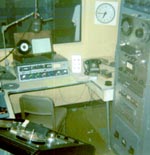
KUDL Production Room, 1969

Freedom with "Bob Scott" (Randy Brown)
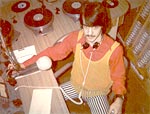
Randy (Bob Scott) at KAKC Tulsa, 1971, wearing Clevites!
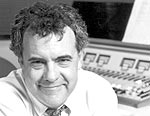
Randy Brown at his last gig in Dallas, imaging production for KRLD NewsRadio 1080 and PD of Texas State Networks (1996).
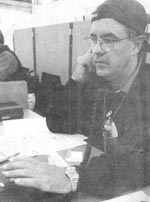
Randy Brown, preparing for a broadcast on PGA Tour radio.
![]()
![]() My folks gave me my first microphone for my 11th birthday. That day at 12:30, President Kennedy was shot in Dallas. The minute I got home from school, I grabbed the microphone (even though it wasn't hooked up to anything) and began "broadcasting" news accounts of the assassination.
My folks gave me my first microphone for my 11th birthday. That day at 12:30, President Kennedy was shot in Dallas. The minute I got home from school, I grabbed the microphone (even though it wasn't hooked up to anything) and began "broadcasting" news accounts of the assassination.
Eventually, my career led me to KGW/Portland, OR, and later, in 1972, to KNUS/Dallas (as Christopher Haze.) In 1973, about half the KNUS staff headed off to El Paso/Juarez to launch "the 150-thousand-watt chili bean," X-Rock 80 (XEROK). Eventually, I returned to the Dallas area, where I spent the better part of the next 23 years, with two brief detours in Houston.

Christopher Haze, "Tuning in, in 1975" But to what?
these men had on my career I carry with me to this day - the imagination of Todd Storz, the discipline of Bill Drake and the promotional savvy of Gordon McLendon. But hey, even if only a little of them rubbed off on me, I consider myself better for it.
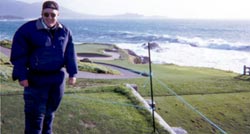
Doing play-by-play for PGA Tour Radio took Randy to some of the most beautiful spots on the planet, including the 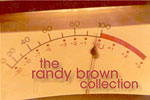

![]() TOP STREAM 44Kbps (20Khz)
TOP STREAM 44Kbps (20Khz)
 PAMS WHB Jingle Montage 1960-1969 (13:59)
PAMS WHB Jingle Montage 1960-1969 (13:59)
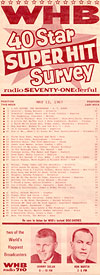
Click to Enlarge
![]() TOP STREAM 32Kbps (16Khz)
TOP STREAM 32Kbps (16Khz)
 Robert W. Morgan, KHJ/Los Angeles, Spring 1967 (14:46)
Robert W. Morgan, KHJ/Los Angeles, Spring 1967 (14:46)
![]() TOP STREAM 16Kbps (8Khz)
TOP STREAM 16Kbps (8Khz)
 Lee Bayley Farewell, KAKC Tulsa, 1971 (02:04)
Lee Bayley Farewell, KAKC Tulsa, 1971 (02:04)
![]() TOP STREAM 32Kbps (16Khz)
TOP STREAM 32Kbps (16Khz)
 Beau Weaver, KNUS Dallas, 1972 Grammy Awards (12:48)
Beau Weaver, KNUS Dallas, 1972 Grammy Awards (12:48)
![]() TOP STREAM 32Kbps (16Khz)
TOP STREAM 32Kbps (16Khz)
 KNUS Dallas Presentation, 1973 (11:32)
KNUS Dallas Presentation, 1973 (11:32)
![]() TOP STREAM 16Kbps (8Khz)
TOP STREAM 16Kbps (8Khz)
 Christopher Haze, XEROK 80, December 1973 (3:54)
Christopher Haze, XEROK 80, December 1973 (3:54)
More to Come from the Randy Brown Collection!

Reel Top 40 Radio Repository ©1996-2013 REELRADIO, Inc.